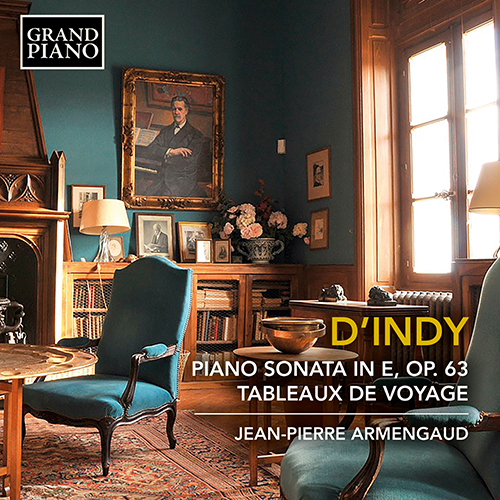INDY, V. d': Piano Sonata / Tableaux de Voyage (excerpts) (Armengaud)
A student of Franck, Vincent d’Indy founded the Schola Cantorum de Paris where he taught for many years. He was also a conductor, with a busy schedule of international touring. His compositions were permeated by the influence of Wagner—he attended the premiere of the Ring cycle—but in time he also absorbed the influence of French folk music, especially from the Vivarais, his ancestral home.
Vincent d’Indy’s large-scale Piano Sonata is one of a small but masterful sequence of non-programmatic instrumental works that he wrote in the first decade of the 20th century. Notable for a novel application of variation form in its opening movement it fuses experimentation with expressive power. Poetic atmospheres and landscapes are evoked in the Tableaux de voyage, postcards of his walks in Germany.
Tracklist

Jean-Pierre Armengaud is considered a leading interpreter of French music and a specialist in impressionist and expressionist repertoire, and is renowned for his ‘fluidly supple playing, his round and mellow tone’ (Classica). He has recorded several complete collections, of piano music by Debussy, Satie, Roussel, Poulenc, Dutilleux and Denisov, and has earned critical acclaim for his recordings of works by Beethoven, Scriabin, Schumann, Chopin, Ravel, Prokofiev and Shostakovich. As a concert artist his programmes are notable for the extent and variety of their repertoire, and he has performed music by Yves Nat, Jacques Février and the Russian pianist Stanislav Neuhaus, with whom he studied in Soviet Russia on one of the first scholarships made available.
Over the last few decades Armengaud has appeared in major concert halls around the world, performing in over 40 countries, and given masterclasses at leading conservatoires. His vast discography includes releases on the Mandala-harmonia mundi, Arts Music and Le Chant du Monde labels among others, alongside the award-winning Debussy Centenary Discoveries and Beethoven’s complete Lieder and songs for Warner Classics. His albums for Naxos and Grand Piano feature music by Debussy, Roussel, Poulenc, Aubert, d’Indy and others, and he has a particular interest in Henri Dutilleux, whose Préludes he has introduced to more than ten countries. As a musicologist and writer he has published a biography of Erik Satie (Fayard, 2009, which won the 2009 Prix des Muses) and a book of essays on Debussy, Claude Debussy: La Trace et l’Écart (L’Harmattan, 2018). He has been director for musical programming at Radio France and provided creative musical direction for the Présences contemporary music festival, and is associate professor at the Paris-Sorbonne University and professor emeritus at the University of Évry Val d’Essonne at Paris-Saclay University.

Vincent d’Indy was born in Paris in 1851 and became a pupil and leading disciple of César Franck, whose music he did much to propagate. He distinguished himself as a teacher, founder of the influential and rigorous Schola Cantorum, and writer on musical subjects, and was an important figure in the musical life of Paris in his time, although by the time of his death a new era in music was well under way.
Orchestral Music
Vincent d’Indy wrote music in all principal genres. His Symphonie sur un chant montagnard français (‘Symphony on a French Mountain Air’) for piano and orchestra, completed in 1886, is overtly patriotic, based on a French folksong. His Fantaisie for oboe and orchestra is based on a French folk-theme. He completed six operas, writing also the libretti for Fervaal, L’Étranger (‘The Stranger’) and La Légende de Saint-Christophe. Incidental music for the theatre includes Médée and Karadec, while his Tableaux de voyage had their origin in a set of piano pieces.
Chamber Music
Although generally associated with larger orchestral forms, d’Indy also composed a certain amount of chamber music. His fourth string quartet was left incomplete, but he contributed to a varied chamber-music repertoire from early in his career until the end of his life.































